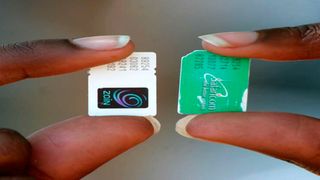
Mobile phone simcards.
| File | Nation Media GroupBusiness
Premium
CRB-listing freeze triggers fraud as defaulters disable SIM cards
Freezing negative listing on the Credit Reference Bureaus(CRBs) is a move that can potentially create a monster going by the latest data from the Communications Authority (CA).
The data shows that when the Central Bank of Kenya (CBK) locked out mobile digital lenders from the CRB listings, a chunk of Kenyans who had borrowed from them flatly refused to pay.
And in the hope to limit the chances of being pursued, nearly 100,000 of them either disabled the SIM cards by removing them from their mobile phones or threw them away altogether and moved on to new numbers.
The data shows the risks creditors are facing following the move by President Uhuru Kenyatta to freeze negative listing for a year.
The populist move will see 99 percent of the 4.6 million loan accounts negatively listed with the country’s CRBs have their data frozen following the suspension of reporting of defaults on loans valued at Sh5 million and below.
However, these creditors, including banks, will no longer be able to vet the 15 million loan accounts to determine the credibility of the borrowers.
With defaults of up to Sh435.7 billion at the end of September, creditors are afraid of lending because they risk handing cash to serial defaulters.
Fraud prevention
“We use the SIM card data for fraud prevention. So far, the solutions are working,” Digital Lenders Association of Kenya (DLAK) Chair Kevin Mutiso said.
He, however, noted the trend where customers throw away their SIM cards is worrying since they can no longer list defaulters.
CA reported that an estimated 100,000 SIM cards were inactive between July and September this year after the mobile money subscribers defaulted on loans.
The number of active mobile money subscriptions dropped to 34.6 million from 34.7 million at the end of June.
“This is attributable to the increase in the number of mobile loan defaulters whose SIM cards remained inactive during the reference period,” the regulator said.
It added that the pandemic triggered significant changes in consumer behaviour, with most consumers decreasing their spending and increasing their borrowing, especially on mobile loan platforms.
In a bid to tame this, digital lenders are using new technology to prevent loan defaults from unscrupulous clients’ ill-motives.
The firms study customers’ loan history through SIM card prevention systems to minimise fraud, such as when a customer dumps SIM cards for a new one after borrowing loans.
Loan default is a big problem for those lending on mobile platforms since the borrowers are not known to the lender. Besides, there is no collateral attached to the loans.
This situation has made mobile lending extremely risky with an estimated five in ten borrowers defaulting on their facilities.
A household survey report released last week by the Central Bank of Kenya, FSD Kenya, and the KNBS showed that more than a half of loans taken through mobile phone platforms are in default in the wake of Covid-19 induced job cuts and business closures that pushed thousands of people into a debt trap. It further shows that 50.9 percent of the respondents have defaulted on mobile loans.
Defaults are generally elevated on the fallout of the Covid-19 pandemic that has left millions out of work or doing menial jobs to make ends meet.
Coronavirus lockdown measures
Kenyans were hit hard by the coronavirus lockdown measures such as dusk to dawn curfews, ban on local and international flights to contain the spread of the virus.
These measures, however, had a huge impact on Kenyans who lost jobs after companies sacked thousands of employees with others shutting down completely as they could not survive the economic meltdown.
Data from the Kenya National Bureau of Statistics (KNBS) showed that the number of people in employment fell to 15.87 million between April and the end of June 2021, compared to 17.59 million the previous quarter.
The government has resorted to a policy of stopping negative listing so that those in trouble can still access loans and get a second chance at resuscitating their businesses or making do while waiting for the next job.
In April 2020, CBK issued a six-month suspension of credit listings, which lapsed in October, allowing financial institutions to start sending names of defaulters to the bureaus.
The freeze was put in place in April last year when 3.2 million loan accounts were listed at CRBs out of 11 million records.
Negatively listed accounts
During the freeze, CBK ordered the removal of borrowers with less than Sh1,000 in defaults which brought down the number of negatively listed accounts.
But the number jumped to 4.6 million after the freeze was lifted in October and listing resumed in January, indicating the tough economic environment witnessed during the pandemic.
While the CRB listing freezes have benefited borrowers, it has negatively exposed digital lenders due to defaults from unscrupulous customers. The lenders rely on CRBs to track customers’ loan history records to prevent defaults.
CBK is warning that most banks and digital lenders will shun borrowers they do not know which may curtail the lending market.
Banks might shun giving credit to individuals and small traders at a scale last witnessed between September 2016 and November 2019 when Kenya capped interest rates, another populist policy that caused immense harm.
Bankers say the lack of credit reference information could contribute to soaring costs of loans and stall lending to businesses due to incomplete borrowers’ information.
The Kenyan economy is currently recovering from the knocks of the pandemic and businesses and households need credit to help them to rebuild.





